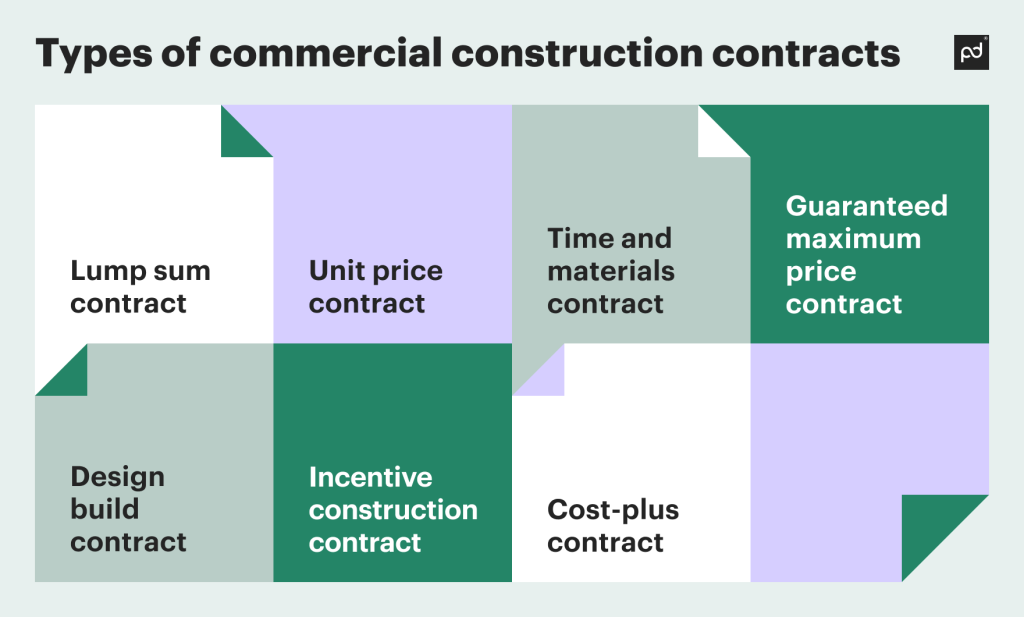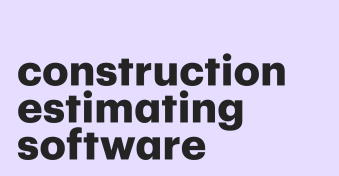Before starting work on a construction project, both the contractor and owner need to sign an agreement — a commercial construction contract — outlining the intricate details.
Depending on the project, the construction agreement could be billed as an upfront lump sum or as units of work.
In this article, we’ll cover the contents of a commercial construction contract.
Continue reading to learn the different types of construction contracts as well as mistakes to avoid.
Key takeaways
- Every contractor needs to draft a construction contract that outlines a plan for the optimal use of resources while guaranteeing maximum profitability.
- Commercial construction contracts cover projects like grocery stores, buildings, public infrastructure, warehouses, airports, medical facilities, apartment complexes, etc.
- A commercial construction contract should contain all parties’ pertinent information, scope of work, payment details, safety measures, and anything else deemed necessary in the specific agreement.
- Calculation errors and unclear objectives are some mistakes that could render your construction contract null and void.
What is a commercial construction contract?
A commercial construction contract is a written agreement between two parties — the contractor and their client — outlining the details of any private or public works project.
This contract differs from general contractor agreements because it demands meticulous attention to detail as well as adherence to a higher degree of legal standards.
You must also show your licenses and certification before you can be awarded the contract.
Commercial construction contracts are used in the following industries:
- Academia: Hostels, dorms, classrooms, sports facilities
- Healthcare: Hospitals, clinics, pharmacies, wellness centers
- Leisure and hospitality: Hotels, amusement parks, recreation centers
- Retail and commerce: Warehouses, malls, service stations
- Transportation and logistics: Ports, terminals, parking facilities, airports.
What are the elements of a construction contract?
Every construction contract written for commercial projects must contain certain elements to be considered valid and binding.
Here they are:
- The project’s scope of work and executive summary
- Personal information and verifiable signatures of all involved parties
- Project timelines, including start and end dates, as well as project phases.
- The project cost as well as payment schedules and methods.
- Provisions for handling change orders, delays, and unforeseen conditions.
- List of subcontractors, construction managers, and partners
- Conditions for completion and termination.
- Certifications, permits, waivers, and licenses from the local or regional authority.
- Conflict resolution mechanisms, safety measures, insurance policies, and penalty clauses.
The stipulations and format for public works contracts vary in different jurisdictions.
For instance, the specifications for a project in New York City differ from those in the state of Ohio.
It’s important to always stay updated about the latest changes in state, county and city regulations when working on a new construction contract.
What are the types of commercial construction contracts?

To understand the various types of commercial construction contracts, let’s use a fictional scenario: The NYC Mayor’s office wants to build 10 new public housing projects downtown as part of “Project ReHouse.”
Here are the types of contracts for this construction project.
Lump sum (fixed price) contract
As the name suggests, this type of construction contract is billed as a fixed lump sum that covers all the project costs.
Lump sum contracts are simple to draft because the contractor needs to come up with an estimate for the entire project.
For instance, the contractor could charge $300 million for Project ReHouse.
Construction companies can use fixed-price contracts when they already know the scope of the project.
This favors companies with experience in a specific type of construction contract because they can make pricing estimates to maximize competitiveness and profitability.
However, charging a lump sum could become risky when the project scope is dynamic and unclear.
You might end up in the loss column if a recession, inflation, or pandemic strikes.
Unit price contract
A unit price contract atomizes entire projects into small bits or “units.”
Instead of presenting a bill for the entire construction project, you can present a detailed estimate for a single unit.
For instance, a unit price contract for Project ReHouse could estimate the actual cost of building one of the 10 housing projects.
This kind of estimate works because all the buildings are identical in terms of material and labor requirements.
Also, unit pricing makes it easy to break down the billing into intricate details. It works for projects with a known end product but a dynamic scope of work.
On the flip side, unit price contracts are more susceptible to economic and socio-economic changes compared to lump sum contracts.
Any spike in price for one unit will increase the total cost exponentially, wiping away all the potential profits from the project.
Time and materials (T&M) contract
T&M contracts are valued according to the amount of time and materials invested in the project.
Here are the two main components:
- Labor costs: the cost of hiring workers or subcontractors, administrative fees, and other work-related expenses.
- Material costs: the price of equipment, building materials, and logistics.
With time and material contracts, you won’t need to factor in several variables, delays, and changes until the project ends.
This works well for construction projects with limited scope, such as roofing installation and landscaping contracts.
However, project owners frown on T&M contracts because they can be easy to manipulate.
Keeping track of the actual billable hours is practically impossible without a stand-in supervisor for the entire project duration.
Also, contractors can overcharge owners for labor to maximize their profits. To counteract this practice, clients add a “not to exceed” clause to construction contracts.
Unfortunately, these restrictions only hamstring contractors, encouraging them to cut corners in order to meet profit margins.
Guaranteed maximum price (GMP) contract
A guaranteed maximum price contract is a variation of the fixed price contract that sets a cap on construction costs at a certain price.
If the contractor exceeds this cap, they’d have to pay out of pocket.
A GMP differs from a fixed-price contract because the contractor has to provide a markup, usually a specified percentage of the entire project.
So, instead of paying $300 million for Project ReHouse, NYC will pay $310 million to cover overheads and contingencies.
Although the property owner pays more under the GMP compared to lump sum contracts, they won’t need to pay for change orders.
This helps the project owner to abdicate responsibility for risks solely to the contractor.
The flip side is that GMP agreements are disadvantageous to contractors, because unforeseen circumstances could land them in legal or financial trouble.
And since change orders are untenable, GMPs often breed conflicts between contractors, subcontractors, and clients.
Design-build contract
As the name implies, a design-build contract hands over both the design and actual building phases to one contractor.
This reduces the time between design and the start of construction.
Design-build agreements are perfect for time-sensitive projects.
This streamlined pathway from design to delivery makes collaboration seamless and increases the speed of completion.
It also eliminates conflicts between designers and contractors.
However, design-build contracts eliminate competition; one construction company designs the project, creates a pricing markup, and builds everything.
As a result, clients might end up paying more than the average market price.
So, for Project ReHouse, the NYC Mayor’s office could pay $10 million for the design and a $300 million lump sum for building the project.
Incentive construction contract
When a project owner promises certain benefits for completing the project within a specified deadline, this is called an incentive construction contract.
These benefits or incentives could come as priority bidding on future projects or monetary compensation.
For example, the NYC administrator could guarantee a new housing project or 10% compensation if the contractor is able to deliver Project ReHouse before 2024.
Due to the incentives involved, construction companies will double their efforts to complete the project in time.
This will also lead to transparency and close collaboration with project owners.
However, these same incentives could lead to disputes if the conditions are not properly defined.
And if the client reneges post factum, you’ll end up in a protracted legal battle. (In our hypothetical NYC example, good luck fighting the government.)
Cost-plus contract
A cost-plus contract is an agreement that guarantees the contractor a bonus payment in addition to the fixed fee.
This bonus payment covers overheads and other miscellaneous expenses not accounted for within the contract.
Cost-plus contracts favor contractors because they protect them from risk and unforeseen circumstances.
This also guarantees a profit margin even if the project exceeds the initial budget.
Unfortunately, project owners might doubt the veracity of accounting after the fact.
This often leads to disputes, especially when the expected bonus payment exceeds the “not to exceed” cap.
Common mistakes when creating a commercial construction contract
One missed clause, one misplaced digit, or one oversight could cost you millions in commercial construction.
To keep your head above the murky waters of commercial construction, here are some common errors to look out for when drafting or reviewing a contract.
Unclear scope of work
A shabbily researched and poorly written scope of work could come back to haunt you once the project starts.
The consequences could be a lack of organizational structure, poor accountability systems, and project delays.
Inaccurate pricing
When estimating the cost of projects, you should always account for every cent.
If you don’t account for price increases, commercial construction projects will bleed your company dry.
Overlooking unforeseen circumstances
Financial crises, recessions, pandemics, and other socio-economic problems are potent factors in large-scale construction.
Since you cannot predict the future, your building contract needs to establish a system for handling contingencies.
Otherwise, it will end up like the Tower of David in Caracas — a monument to biting off more than one can chew.
Choosing the wrong partner
Another common mistake is in the choice of partners and subcontractors.
If you outsource parts of your project to a poorly managed company, you’ll end up in multiple lawsuits trying to get them to fulfill their end of the deal.
Vague contract stipulations
Contractors often make grave errors in judgment by blindly trusting clients and partners.
You can fall into this trap when you use a generic construction template without reviewing the contents.
This error extends to the scope of work and other granular details such as change orders and risk management.
Ignoring local law
All jurisdictions — from cities, counties, states, provinces and up to the federal level — have unique construction regulations regarding labor, material usage, and equipment.
Breaking any of these rules might incur fines or even lead to your permit getting revoked.
For instance, NYC law mostly prohibits the use of asbestos in modern construction projects, but some states still allow the use of this dreadful material.
Some countries don’t even regulate asbestos or other toxic building materials.
Why do you need a commercial construction contract?
A commercial construction contract protects both the builder and the owner from lawsuits and disputes.
It also fosters transparency in pricing and administration.
The right contract can also incentivize the contractor to speed up the project delivery timeline without cutting corners.
For state-owned projects, a thoroughly researched construction contract will keep you in good stead with the law and guarantee future cooperation.
Here are the best practices for drafting or executing a commercial construction contract.
- The scope of work should define administrative strategies, construction phases, risk factors, timelines, and milestones.
- Get your licenses, permits, certifications, and insurance policies in order.
- Use professional contract templates to speed up negotiations.
- Establish a quality control mechanism at the end of every construction phase.
- Create realistic schedules that account for unforeseen circumstances.
- Choose subcontractors and partners with a clean record of ethical practices.
- Conduct regular meetings with project managers to share updates and challenges.
- Hire an expert to draft and negotiate the contract.
- Specify a unit price or lump sum amount in the contract.
- Document every dime spent on the project for accountability and transparency.
- Add indemnification, exculpatory, and other relevant clauses to the contract.
- Stay up to date with changing construction regulations.
- Prioritize safety on the job site.
Which commercial construction contract is the best?
If your scope of work is clear, you can use a lump sum contract.
But if the scope of work is dynamic and flexible, a time and materials contract could be the best option for you.
For projects with identical mini-projects, you can atomize the lump sum to unit costs using a unit price contract.
Or you can use a cost-plus or GMP contract to cover overheads.
In time-sensitive contracts where the project owner has stipulated a bonus payment for timely completion, use an incentive construction contract.
How PandaDoc can help you with commercial construction contracts
Our contract management system provides you with a rich library of contract templates.
You can get a general construction template or opt for ultra-specific ones, such as for roofing or bathroom installation.
With the PandaDoc editor, you can make changes to the contract language and personalize your contracts with headers and other custom fields.
You can also use the eSignature solution to sign and assign signature fields to clients.
To find out more about PandaDoc’s contract management solution, visit the learning academy or book a demo.
You can also start 14-day trial to explore its capabilities and start onboarding.
Frequently asked questions
-
The elements of a construction contract include the executive summary, scope of work, payment details, and contingencies. Other elements include certifications, permits, additional clauses, safety measures, and conflict resolution mechanisms.
-
The common types of contracts include lump sum or fixed price contracts, unit price contracts, time and materials contracts, incentive contracts, cost plus contracts, and design-build contracts.
-
A commercial contract involves drafting an agreement that outlines how you wish to accomplish the project goals. The next stage is to hire subcontractors, gather equipment, and prepare the site. Then you can start building. At the end of every phase, you need to carry out quality control to assess progress and fix any defects found.
-
Some examples of commercial building construction include grocery stores, buildings, public infrastructure, warehouses, airports, medical facilities, and apartment complexes.
Disclaimer
PandaDoc is not a law firm, or a substitute for an attorney or law firm. This page is not intended to and does not provide legal advice. Should you have legal questions on the validity of e-signatures or digital signatures and the enforceability thereof, please consult with an attorney or law firm. Use of PandaDoc services are governed by our Terms of Use and Privacy Policy.


